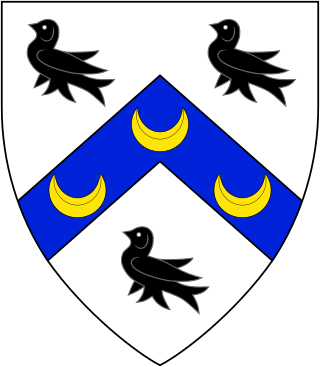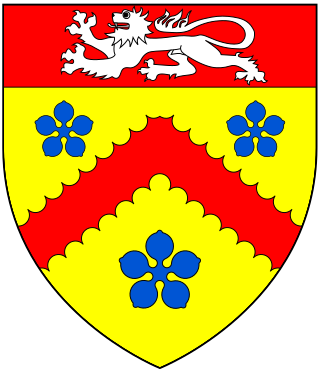Related Research Articles

Marquess of Zetland is a title in the Peerage of the United Kingdom. It was created on 22 August 1892 for the former Lord Lieutenant of Ireland, Lawrence Dundas, 3rd Earl of Zetland. Zetland is an archaic form of Shetland. The Dundas family descends from the wealthy Scottish businessman and Member of Parliament, Lawrence Dundas. In 1762 he was created a Baronet, of Kerse in the County of Linlithgow, in the Baronetage of Great Britain. The title was created with remainder, failing heirs male of his own, to his brother Thomas Dundas and the heirs male of his body. He was succeeded by his son, the second Baronet. He represented Richmond and Stirling in the House of Commons and also served as Lord Lieutenant of Orkney and Shetland. In 1794 he was created Baron Dundas, of Aske in the North Riding of the County of York, in the Peerage of Great Britain. Lord Dundas notably purchased the right to the earldom of Orkney and lordship of Zetland from James Douglas, 14th Earl of Morton.

Marquess of Linlithgow, in the County of Linlithgow or West Lothian, is a title in the Peerage of the United Kingdom. It was created on 23 October 1902 for John Hope, 7th Earl of Hopetoun. The current holder of the title is Adrian Hope.

Earl of Galloway is a title in the Peerage of Scotland. It was created in 1623 for Alexander Stewart, 1st Lord Garlies, with remainder to his heirs male bearing the name and arms of Stewart. He had already been created Lord Garlies in the Peerage of Scotland in 1607, with remainder to the heirs male of his body succeeding to the estates of Garlies. This branch of the Stewart family were distant relatives of the Stewart Kings of Scotland.

Viscount St Davids, of Lydstep Haven in the County of Pembroke, is a title in the Peerage of the United Kingdom. It was created in 1918 for John Philipps, 1st Baron St Davids. The Philipps family descends from Sir John Philipps, who represented Pembrokeshire in the House of Commons. In 1621 he was created a Baronet, of Picton Castle in the County of Pembroke, in the Baronetage of England. His grandson, the third Baronet, also sat as Member of Parliament for Pembrokeshire. He was succeeded by his son, the fourth Baronet. He represented Pembroke and Haverfordwest in Parliament. His son, the fifth Baronet, sat for Haverfordwest. He was succeeded by his younger brother, the sixth Baronet. He represented Carmarthen, Petersfield and Pembrokeshire in the House of Commons.

Baron Glentoran, of Ballyalloly in the County of Down, is a title in the Peerage of the United Kingdom. It was created on 8 July 1939 for the Unionist politician Herbert Dixon. In 1950 he also succeeded his elder brother as third Baronet, of Ballymenock. His son, the second Baron, was also a politician and served as the last Speaker of the Senate of Northern Ireland. As of 2017 the titles are held by the latter's son, the third Baron, who succeeded in 1995. He is a former Olympic bobsleigh gold medallist as well as a soldier, businessman and politician. Lord Glentoran was one of the ninety elected hereditary peers who remain in the House of Lords after the passing of the House of Lords Act 1999, and sat on the Conservative benches until his June 2018 retirement under the House of Lords Reform Act 2014.
There have been four baronetcies created for persons with the surname Clark, all in the Baronetage of the United Kingdom. Two of the creations are extant as of 2010.
There have been five Baronetcies created for people with the surname Forbes, four in the Baronetage of Nova Scotia and one in the Baronetage of the United Kingdom. The first holder of the Burn Baronetcy of Jessfield, created in the Baronetage of the United Kingdom in 1923, assumed the surname of Forbes-Leith of Fyvie in 1925.

There have been four Baronetcies created for persons with the surname Harris, two in the Baronetage of England and two in the Baronetage of the United Kingdom. One creation is extant as of 2010.

There have been twenty one baronetcies created for persons with the surname Williams, eight in the Baronetage of England, three in the Baronetage of Great Britain and ten in the Baronetage of the United Kingdom. Only six of the creations are extant as of 2017.

There have been four baronetcies created for persons with the surname Hope, three in the Baronetage of Nova Scotia and one in the Baronetage of the United Kingdom. As of 2010 one creation is extant, one dormant and two extinct.
There have been four baronetcies created for persons with the surname Hall, one in the Baronetage of Nova Scotia and three in the Baronetage of the United Kingdom. Three of the creations are extant as of 2010.
There have been nine baronetcies created for persons with the surname Moore, two in the Baronetage of England, one in the Baronetage of Ireland, two in the Baronetage of Great Britain and four in the Baronetage of the United Kingdom. As of 2014 two creations are extant and one is considered dormant.
There have been three baronetcies created for persons with the surname Nicholson, all in the Baronetage of the United Kingdom.

There have been eight baronetcies created for persons with the surname Wilson, one in the Baronetage of Ireland and six in the Baronetage of the United Kingdom.
There have been six baronetcies created for persons with the surname Thomas, three in the Baronetage of England, one in the Baronetage of Great Britain and two in the Baronetage of the United Kingdom. Two of the creations are extant as of 2016.

There have been seven baronetcies created for persons with the surname Watson, one in the Baronetage of England, one in the Baronetage of Great Britain and five in the Baronetage of the United Kingdom. One creation is extant as of 2016.
There have been four baronetcies created for persons with the surname Dundas, one in the Baronetage of Great Britain and three in the Baronetage of the United Kingdom. One creation is extant as of 2008.

There have been three baronetcies created for persons with the surname Cooke, two in the Baronetage of England and one in the Baronetage of Ireland. One creation is extant as of 2013.

The Dalrymple, later Dalrymple-Hamilton, later Hamilton-Dalrymple Baronetcy, of North Berwick in the County of Haddington, is a title in the Baronetage of Nova Scotia. It was created on 29 April 1697 for the Hon. Hew Dalrymple, Lord President of the Court of Session under the judicial title of Lord North Berwick from 1698 to 1737. He was the third son of James Dalrymple, 1st Viscount of Stair, and the brother of John Dalrymple, 1st Earl of Stair, Sir James Dalrymple, 1st Baronet, of Cranstoun, and Sir David Dalrymple, 1st Baronet, of Hailes. The second Baronet sat as Member of Parliament for Haddington and Haddingtonshire. The third Baronet represented Haddingtonshire in the House of Commons. The fourth Baronet was Member of Parliament for Haddingtonshire, Ayrshire and Haddington. He assumed the additional surname of Hamilton after that of Dalrymple. The fifth Baronet sat as Member of Parliament for Haddington. The eighth Baronet assumed the surname of Hamilton before that of Dalrymple. The tenth Baronet was Lord-Lieutenant of East Lothian from 1987 to 2001.
There have been five baronetcies created for persons with the surname Home, four in the Baronetage of Nova Scotia and one in the Baronetage of the United Kingdom. Only one creation is extant as of 2008.
References
- ↑ "No. 30557". The London Gazette . 5 March 1918. p. 2782.
- Kidd, Charles, Williamson, David (editors). Debrett's Peerage and Baronetage (1990 edition). New York: St Martin's Press, 1990.
- Leigh Rayment's list of baronets